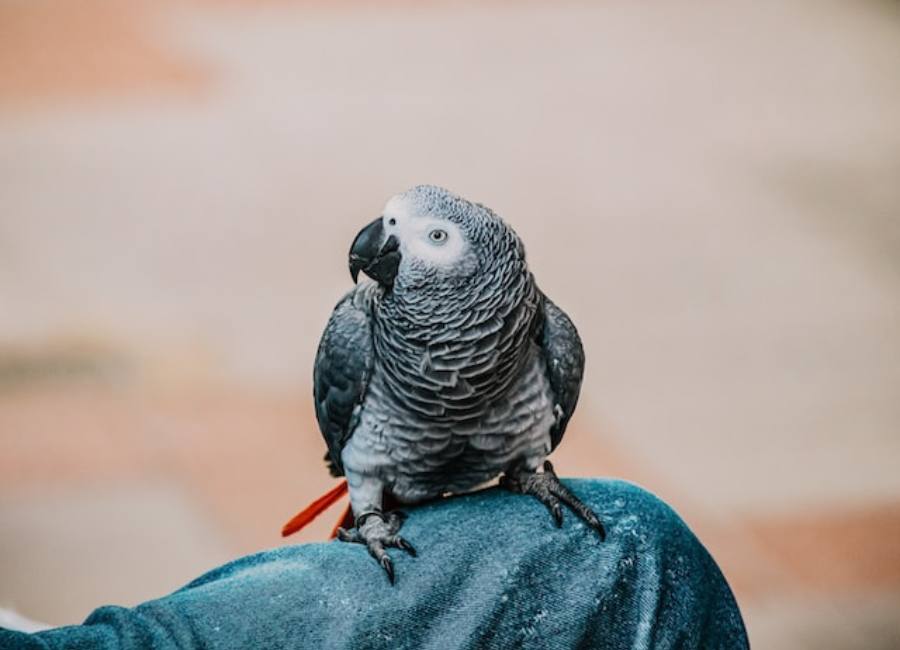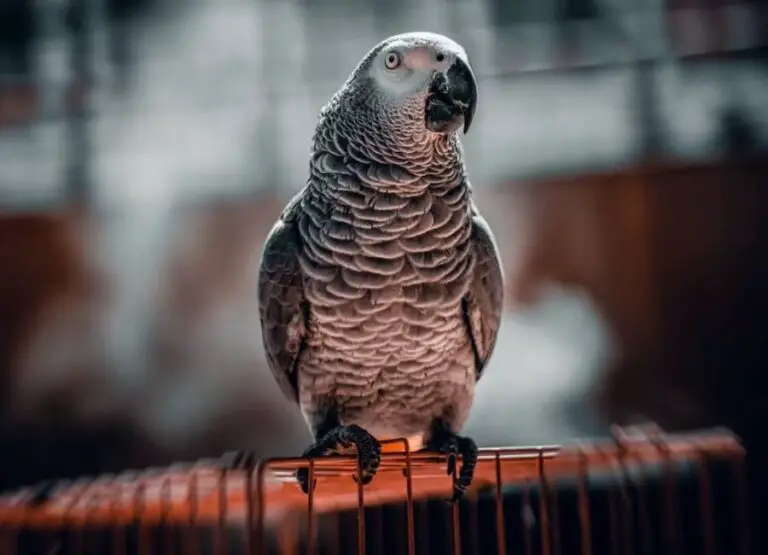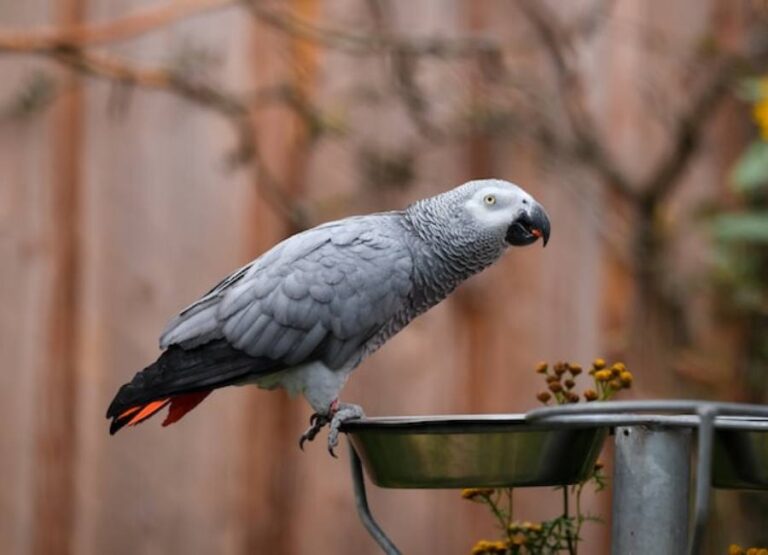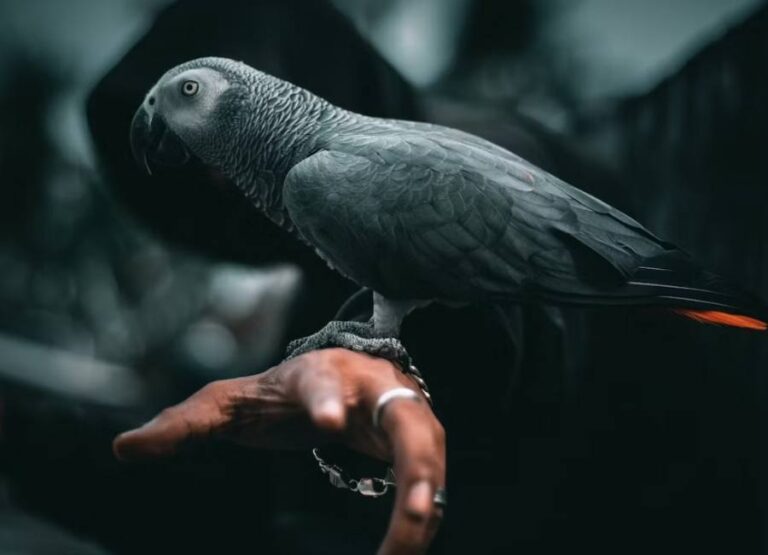24 African Grey Body Language Explained

If you’re looking to bring home a pet bird, an African Grey Parrot might just be the perfect fit for you!
These intelligent and affectionate birds are known for their exceptional mimicking abilities, loyalty, and, of course, their expressive body language.
From fluffed feathers to dilated pupils, an African Grey’s body language can tell you all you need to know about their thoughts and emotions.
In this blog post, we’ll explore the fascinating world of African Grey body language and what it can tell us about our feathered friends. So grab a cup of tea and let’s dive in!
African Grey Body Language
African Grey parrots communicate through a variety of body language signals.
These can include puffing up their feathers, lowering their head, and widening their eyes.
They may also flap their wings or bob their head as a way of showing excitement or agitation.
By understanding these signals, owners can better interpret their parrot’s behavior and respond appropriately.
The followings are some common African grey body language signals and their meanings:
1. Flapping Wings
Flapping wings is a common habit associated with joyous and ecstatic African Grey Parrots. It represents their eagerness and playful spirit.
They energetically flap their wings when they are happy or while they are in flight.
This behavior allows them to expend energy, show their vitality, and express their excitement and passion.
2. Foot Tapping
Foot tapping is a common activity among African Grey Parrots.
It entails tapping their feet rhythmically on a perch or a surface. Foot tapping is a common indication of anticipation or excitement.
It is most typical when they are anticipating something, such as food, attention, or engaging in interactive play.
They express their desire and engage in a lively engagement by tapping their feet.
3. Wing Drooping
Wing drooping is a body language cue in which African Grey Parrots lower their wings and allow them to hang slightly.
Depending on the context, it can have several meanings.
Wing drooping can be a sign of satisfaction and relaxation, showing that they feel safe and comfortable.
It is usually noted while they are at rest or in a relaxed mood.
However, if wing drooping persists or is accompanied by other indicators of disease or pain, it is critical to monitor their overall behavior and health.
4. Puffing Up
African Grey Parrots puff up to express various emotions. They appear larger and more voluminous as they puff up their feathers.
It can be an aggressive show, especially when combined with other hostile body language indicators like flared crest feathers or widened eyes.
Puffing up, on the other hand, might show excitement and enthusiasm.
They may puff up their feathers in situations of heightened delight or anticipation, providing a visually striking look.
5. Head Tilting
African Grey Parrots are well-known for their endearing head tilting. They display active listening and alertness by tilting their heads to the side.
They can more efficiently focus on specific noises or stimuli by shifting their head posture.
They may gather more information by tilting their heads, which also indicates their high level of perceptiveness and cognitive engagement with their surroundings.
6. Beak Grinding
African Grey Parrots generate a repetitive movement and sound called beak grinding. It is frequently heard when people are comfortable and content.
Beak grinding is prevalent during relaxation periods or right before falling asleep.
The contact between their top and lower beaks causes the grinding sound.
This is a self-soothing process that represents a sense of comfort, well-being, and relaxation.
7. Tail Fanning
Tail fanning is a body language indication that African Grey Parrots use to spread their tail feathers apart.
Depending on the context, this conduct can have a variety of connotations. It can be a sign of eagerness and interest in some circumstances.
When they come across anything interesting or entertaining, they may fan out their tail feathers.
Tail fanning in African greys, on the other hand, can be an aggressive or warning gesture.
Tail fanning, when combined with vocalizations and other body language cues, might reveal information about their current emotional state and goals.
8. Fluffing
Fluffing is a behavior in which African Grey Parrots puff up their feathers to seem larger and more voluminous.
This is frequently noted while they are at rest or preparing to sleep.
They create pockets of air within their plumage by fluffing up, which provides insulation and helps preserve body heat.
Fluffing is a sign of relaxation and comfort, showing that they are comfortable and safe in their surroundings.
9. Preening
Preening is an important grooming habit in African Grey Parrots.
They diligently clean and arrange their feathers with their beaks. Preening serves several functions.
It keeps their plumage in good condition by eliminating dirt, dust, and parasites.
Furthermore, it serves as a social bonding activity within their flock or human family.
Preening each other’s feathers strengthens social relationships and fosters trust and affection.
10. Eye Pinning
African Grey Parrots have an amazing capacity to express their emotions through their eyes.
Eye pinning is a behavior in which the pupils tighten and dilate rapidly. It can represent a variety of feelings, including enthusiasm, curiosity, and even terror.
When they are aroused or interested in anything, their eyes pin, shrinking and then expanding.
If they feel threatened or terrified, their pupils may dilate fast.
Understanding the context as well as the associated body language clues is critical in deciphering the exact meaning behind their eye pinning.
11. Wing Fluttering
Wing fluttering is a typical characteristic among African Grey Parrots. It allows them to stretch and strengthen their wing muscles.
They retain their agility and strength by swiftly flapping their wings while poised.
Wing fluttering is a natural action, and it is a healthful kind of physical activity when done in moderation.
However, if they flutter their wings excessively or appear agitated while doing so, it may suggest discomfort or anxiety, necessitating more attention and inspection.
12. Head Bobbing
The characteristic head-bobbing movement of African Grey Parrots is well known.
This rhythmic movement conveys inquiry and attentiveness.
They bob their heads up and down when they see something interesting or interact with their surroundings.
It’s their method of demonstrating good observation and a drive to discover.
Head bobbing can also serve as an invitation to play, allowing them to interact with their human friends.
13. Feather Ruffling
When African Grey Parrots ruffle their feathers, it indicates that they are at ease and relaxed.
They fluff their feathers to generate an insulating layer that regulates their body temperature and gives them a warm sensation.
It implies that they are at ease and content with their surroundings.
Feather ruffling is frequently noticed when birds are sitting in a familiar and safe habitat and are content.
14. Vocalizations
African Grey Parrots are well-known for their amazing ability to imitate a wide range of sounds, including human speech.
Their vocalizations are an effective form of communication and expression.
They have the ability to imitate a wide range of noises, tones, and pitches, allowing them to express their emotions, needs, and desires.
They can show enjoyment, contentment, fear, or even a desire to engage with their human companions through their vocalizations.
Paying great attention to their speech cues, as well as their body language, provides vital insights into their current mental state.
15. Beak Clicking
Beak clicking is a behavior in which African Grey Parrots rapidly tap their beaks together to make a clicking sound. This conduct can have several interpretations.
It can represent eagerness or anticipation, especially if they are expecting something rewarding or entertaining.
Beak clicking can also function as a kind of communication, signaling a desire for engagement or attention from their human companions.
16. Regurgitation
Regurgitation is the act of bringing up partially digested food from their crop and offering it to their bonded spouse or human companion.
This is an expression of affection and bonding. It is most typically seen during courtship rituals or as a kind of social bonding within their flock or human family.
17. Head Scratching
African Grey Parrots use their paws or beaks to scratch their heads. Scratching one’s head is a self-soothing habit that can imply ease and relaxation.
It relieves them of any irritation or pain they may be feeling. Head scratching can also be a sign of happiness and joy.
18. Ladder Wing Display
African Grey Parrots may do a ladder wing show in specific circumstances.
This action entails stretching one wing out to the side and repeatedly raising and lowering it, similar to the rungs of a ladder.
The ladder wing display can act as a territorial or aggressive display, showing dominance or defending one’s space.
19. Foot Lift
Foot lifting is a behavior in which African Grey Parrots raise one foot off the perch or surface for a brief period of time.
This activity can have several objectives. Foot lifting is sometimes only a means for people to reposition themselves or change their balance.
It can, however, be a sign of attentiveness or preparation for action, indicating that they are ready to respond to stimuli or engage in activities.
Find out more about African grey aggression.
20. Tail Wagging
Tail wagging is a behavior in which African Grey Parrots move their tail from side to side in a gentle, rhythmic motion.
Tail wagging can indicate a happy emotional state like satisfaction, pleasure, or anticipation.
It is frequently observed during interactive play or when they are involved in activities that they enjoy.
Tail-wagging is also a means for them to express their desire for attention or interaction.
21. Beak Flaring
Beak flaring is a behavior in which African Grey Parrots broaden and open their beaks for a brief period of time.
This can happen in a variety of settings. The flaring of the beak may suggest surprise, enthusiasm, or even a warning.
To accurately comprehend the exact meaning behind this conduct, analyze the underlying body language and context.
22. Body Flattening
African Grey Parrots flatten their bodies against a surface, such as a perch or the ground, in a behavior known as body flattening.
This body stance can convey a variety of emotions. When they flatten their bodies with their wings slightly extended, it might be a protective or submissive gesture, implying fear or anxiety.
If they flatten their bodies with their wings near their sides, it can imply rest and contentment.
23. Sideways Stance
African Grey Parrots may take a sideways stance at times, turning their body to the side while keeping their head forward. This position can suggest distrust or caution.
They extend their range of view by taking a sideways position, allowing them to analyze their surroundings more attentively and maybe identify any potential threats or changes.
24. Crest Feather Position
On top of their heads, African Grey Parrots have a characteristic feather crest.
The position of their crest feathers can reveal their emotional condition. Raised and upright crest feathers suggest increased attentiveness, curiosity, or even hostility.
If their crest feathers are relaxed and closer to their head, it indicates a more peaceful and contented disposition.
Find out more about identifying an unhappy African grey parrot.
Building a Strong Relationship with an African Grey Parrot
African Grey Parrots are highly intelligent and social birds, requiring a lot of interaction and attention from their owners.
Building a strong relationship with an African Grey Parrot takes time, patience, and effort.
Here are some tips for building a strong relationship with an African Grey Parrot:
- Spend time with your parrot every day. African Grey Parrots are social birds and need daily interaction with their owners.
- Provide your parrot with a variety of toys and activities to keep them entertained and engaged.
- Talk to your parrot often and use a variety of words and phrases. African Grey Parrots are known to mimic human speech and appreciate attention and interaction.
- Offer your parrot healthy foods, such as fresh fruits and vegetables, in addition to their regular diet of pellets and seeds.
- Establish a consistent routine for feeding and interaction with your parrot. This will help them feel secure and comfortable in their environment.
- Provide your parrot with a safe and comfortable living space. This includes a clean cage, fresh water, and plenty of room to play and exercise.
- Attend to your parrot’s grooming needs, such as trimming their nails and wings and giving them regular baths.
- Be patient and consistent with training and behavior modification. African Grey Parrots are intelligent birds and can be trained to do tricks and follow commands.
- Show your parrot affection through gentle petting, scratching, and cuddling. This will help them bond with you and feel secure in their relationship with you.
Find out more about how to identify a happy African grey parrot.
Conclusion
In conclusion, understanding African Grey body language is crucial for any pet owner or lover of these beautiful birds.
By paying attention to their subtle cues, we can better communicate with them and ensure their well-being.
So next time you’re spending time with your African Grey, take a moment to observe their body language and respond accordingly. Trust us, it’ll be worth it!



![Why is my African Grey Aggressive [11 Reasons] Why is my African Grey Aggressive](https://petcreeks.com/wp-content/uploads/2023/06/Why-is-my-African-Grey-Aggressive-768x555.jpg)

